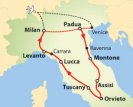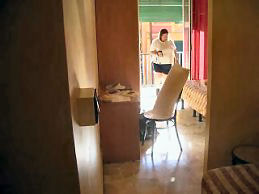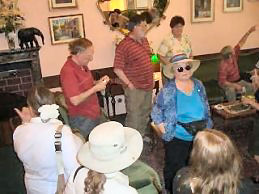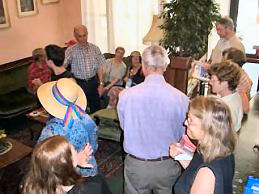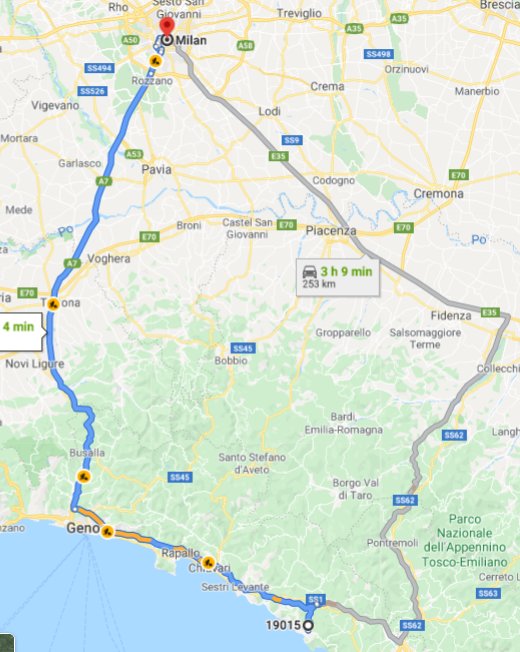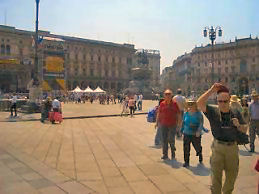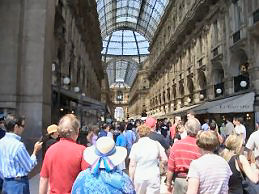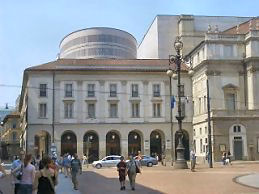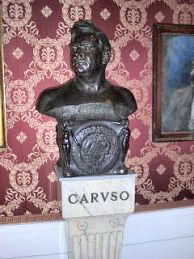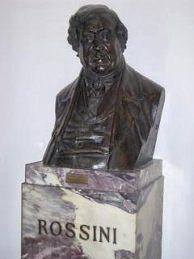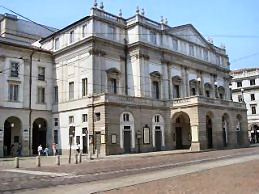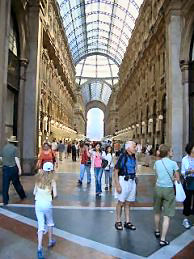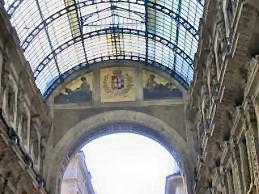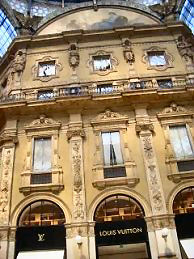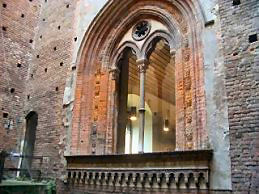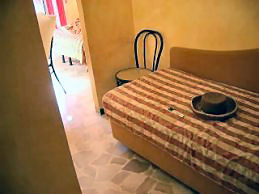
The world was still spinning a little when I got up in the morning. I worked a little on my journal, but I confess that I did not make a lot of progress. I had to place my hopes in devoting a good bit of the drive to Milan catching up on it. I was more than a day behind.
The breakfast was as good as it had been the previous day. In every respect Albergo Primavera was a great little hotel. I really liked both it and the town of Levanto.
A car and a truck had evidently been involved in a minor accident on the narrow road leading out of Levanto. When our bus arrived at the scene, the truck was pulled over to one side of the road. Around the corner the car was pulled over on the other side. The people appeared to be exchanging information in front of the truck. It took all of Mario's skill to negotiate around them and through the oncoming traffic.
I expected the breakfast to settle my stomach and my queasiness. It helped a little, but it was still well beyond my capacity to work on the computer on the bus. I didn't want to be the only person forced by nature to use the bus's bathroom in an emergency situation.
Nina, who now holds dual citizenship, used the drive to Milan to try to give us a short course in Italy's complicated political system. I already knew almost all of this. I asked some questions about Ciampi and the role of the Senate, but I was not sure in the end that she understood any more about their function than I did. I asked her about Berlusconi's scheme to unite the four major conservative parties into a partito unico. She didn't think that it would work, but I think that she may have been underestimating his abilities in the political arena.
I did learn that five of the twenty regions are semi-autonomous. I later learned that they are Sardinia, Sicily, Valle d'Aosta, Trentino Alto Adige, and Friuli Venezia Giulia.
Nina said that the Italian healthcare system is pretty good and almost free. She said that the retirement situation is a real problem because people are used to retiring with a pretty good pension at an early age. There are not nearly enough young workers to sustain this situation, and the next generation is almost non-existent. According to Nina the regions in which the Communists are in power have traditionally been the best-run. Go figure.
She told us that Italians get married very late in life and live with their parents. Evidently the concept of a mortgage has not yet caught on in Italy. Italians pay cash for everything, even houses! The parents might help newlyweds purchase a house or apartment. The mammas cook, sew, and in many other ways provide for their sons well into middle age. The men are therefore spoiled rotten when it comes to domestic duties. Even after marriage, Italian homes often contain three generations. The grandparents raise the kids while the parents work.
Nina also said that in Italy monogamy is widely considered contrary to nature. The corollary to this is that many Italians think that cheating on their spouse, if done discretely, is OK. She said that she was surprised at how widespread this notion is.
We stopped in an Autogrill (actually it wasn't called that, but I was pretty sure that it was affiliated with Autogrill) for a break. I looked for a CD there, but the selection was poor. I almost bought an Oggi magazine, but I changed my mind at the last minute. It will take me a long time to get through the book that I bought in Siena.
Nina found out everyone's departure plans. She asked who wanted to try to share a ride to the airport. Tom set it up so that we would depart on Sunday at 7:15 a.m. The Doggetts were going to join us. Nina called ahead to the hotel and asked them to get cabs for us.
We arrived in Milan a little before noon. Mario parked the bus at the Largo Cairoli, the traffic circle and piazza that contained the requisite statue of Garibaldi. We all said Arrivederci' and Grazie' to Mario, and then everyone but Sue walked from there a few short blocks to the Hotel London. I brought my stuff to the hotel, got the key to room #22, went up two flights of stairs, set down my backpack and my suitcase, emptied out the grey canvas bag, and then returned to help Sue carry the rest of the stuff, including the big cardboard box from the ceramics store in Deruta, to the hotel.
As it happened I overheard the desk clerk calling for our taxi: Sette e quindici. Sei persone e tanti bagagli.
Sue said that she wasn't hungry, but I was, at least a little. She stayed in the room to work on her movies and photos. I went out for a stroll in order to find something to snack on. I settled on a package of cheese puffs that I purchased from a stand on the Largo Cairoli. There I noticed a stand that was renting bicycle-sedan chairs. At first this seemed extremely dangerous in light of the heavy traffic in Milan, but then I discovered Via Dante, a street that was closed to traffic. It was lined with cafes and toney retail establishments. I found a bookstore with lots of remainders, but there was nothing in it that interested me. I looked for a record store, but I could not find one. We were in Milan for a day in 2003, but we never came across Via Dante. I can't imagine how we missed it. I must have been very close to it on the first day when I got lost looking for the post office.
We met at 2:30 for a short tour of the area with our local guide, Lorenza. We started by walking toward the Duomo. We didn't even walk around the church itself to marvel at the ornate design and the thousands of statues. Instead we sped through the Galleria to La Scala, which had been closed for renovations the last time that we were in Milan. I took quite a few pictures of the statue of Leonardo da Vinci along the way.
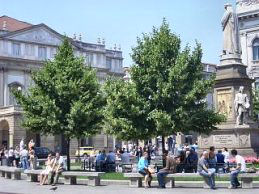
Lorenza led us into the museum. It mostly seemed to consist of statues and portraits of lots of composers and singers and, in Verdi's case, his wives. This was boring even to an opera fan like myself. I can't imagine what the other people must have thought about it. Then we got to peek into the theater from a box. I saw pretty much what I expected to see, except that an orchestra was tuning up in the area of the orchestra pit. They had built a temporary stage over the pit itself, so you did not get the feel of what it would be like to be at an opera. The boxes were tiny, which was a surprise to everyone else.
It was something of a thrill to be inside La Scala, but what I really wanted to see was the stage, and it was covered by a screen. Frankly, the inside of La Scala looks pretty much like the inside of any European opera theater. It was the stage and the acoustics that set it apart.
Lorenza tried to used the scale models to explain the intent of the reconstruction, but at the end I had little idea what they had accomplished by adding the box and the oval. I guessed that it must have provided more room, but I did not comprehend what they were planning to do with it.
Next we went back through the Galleria. I noticed that the bookstore in which I purchase my spiral notebook in 2003 was no longer there. I doubt that I could have returned the notebook any way. It doesn't exactly look new.
Lorenza explained that the Galleria, which means tunnel, was originally constructed not for retail, but to allow people to go from the Duomo to La Scala without getting too wet. Now, of course, it is full of pricey retailers and cafes, even more so than Via Dante. She also explained about the murals, which for some reason portray four of the five (not a mistake; Lorenza said that Italians think that there are only five) continents. I did not find any of this very enthralling either. She showed us the bar in which Campari was invented. It had a different proprietor in 2005 because according to Lorenza no one company was allowed to stay in the Galleria for more than ten years. Maybe this explained the demise of the bookstore.
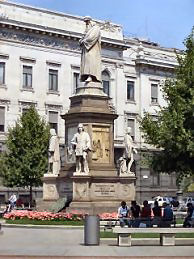
Sue bailed out of the tour as we reached the Galleria for the second time. Before she left she drew my attention to the large music and video store that was there. I had never even noticed it. I resolved then and there to come back after the walking tour to pick up a CD of Roberto Murolo songs.
This time we left the Galleria and went into the Duomo itself. This must have been the worst tour of the Duomo imaginable. We spent absolutely no time on the fascinating faηade or the unbelievable roof. Instead we went right inside, where a priest was leading a congregation on one side of the church in the saying of the rosary. Lorenza therefore had to speak in a whisper. To make it worse, much of the church was cordoned off. She went on and on about how it took 500 years to build the church and how the Visconti family had donated all of the marble, as well as the transportation to get it here. She showed us the crest of the Visconti family in the rose window as well as the hole in the wall that tells the month at noon (1 p.m. daylight time) and the red dot where there is supposedly a nail from the true cross. She skipped the statue of St. Bartholomew, which I considered the most interesting thing in the whole church.
We skipped the roof! The roof of the Duomo – the most interesting place in all of Milan – wasn't even mentioned! I could not believe it. I proposed to Tom that we skip the rest of the tour to go see the roof, but he said that his knees were not up to any more climbing.
We noticed that there was a big concert scheduled for the Piazza del Duomo. We could see the stage that had been erected on one side of the piazza. Nina told us that Duran Duran would be there on Sunday night for the end of the bike race. We would be long gone by then. Later we learned that the Black Eyed Peas had performed on Saturday evening.
Next we walked up Via Dante to the Sforzesco Castle. It was named after a famous mercenary named Francesco Sforza who married into the fabulously wealthy and powerful Visconti family. The castle was built near the edge of the Roman walls. Lorenza noted that there about forty thousand people lived in the city in the middle ages. The new walls were built in 1450, and then a third set was constructed in 1570. The city kept expanding in a circle, as it is still doing. In 2005 approximately 1.4 million people resided in Milan.
The city took over the castle and made it into a museum in 1905. Leonardo da Vinci evidently designed the towers as a prison. However, for some reason they did not use his design. Milan, which was then called Mediolanus, was the capital of the Western Roman Empire for a while in the fourth century. I have learned from the book that I bought in Assisi that Ravenna, of all places, held that distinction for much of the period after Constantine abandoned Rome. The museum featured several statues and depictions of the city's patron, St. Ambrose. Almost all of them portrayed him with a whip.
One room in the castle had a ceiling that has a copy of Leonardo's original fresco. Evidently the original fell apart. I took a photo of the oldest window in Milan.
The highlight of the tour was supposed to be a look at the Pietà Rondini. It looked to me like a half-finished mess that Michelangelo Buonarotti started but died without finishing. My uneducated opinion was that it was more likely that he just gave up on it. I could hardly believe that it has survived all of these centuries. I certainly didn't see why anyone placed much importance on it.
To me this tour of Milan was the biggest disappointment of the entire trip. It wasn't as excruciating as the ceramics factory, but I found it to be so much less than it could have been. The only redeeming feature was the peek inside La Scala.
Nina was acting mysterious just before the tour started. She said a couple of times that we might be able to do something extra. I don't think that this ever happened, or if it did, I didn't notice it.
After the tour I walked back down to the Galleria. The record store there encompassed three stories, but for some reason there was no merchandise at all on the ground floor. You had to go down for popular music or up for classical. I must have spent twenty-five minutes looking for CD's by Roberto Murolo. I figured that they would be in the Italiana section of the basement, but in fact they were in the much smaller Regionale section. I guess that this must have been because the songs were sung in the Neapolitan dialect. At any rate I picked up an inexpensive one. If it turned out to be any good, I would make a copy and give the original to Lydia.
We all gathered for a final drink at the Caffè Dante, an indoor-outdoor bar on the Via Dante. Nina suggested that we try a Negroni, which is a powerful combination of three liqueurs. Most of us tried it. It was strong, but not particularly delicious. The waiters kept bringing snacks – nuts and olives and chips. Several people had a second drink. Bob even ventured a second Negroni. My last memory of him was holding a large drink while perched delicately on his seat. They must have had to bring him back to the hotel in a wheelbarrow.
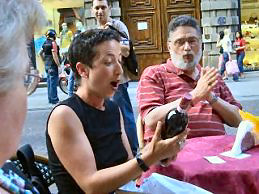
Pat Beckett had taken a collection in order to purchase a nice bottle of wine to give to Nina. The presentation took place at the next table over from where I was sitting. I got a truly great picture of Nina's reaction as well as that of a young man walking by on the Via Dante.
The four of us said good-bye to everyone, and then we intrepidly set off for the Ristorante Fortunio, which Nina had told us was on the other side of La Scala, for supper. Nina had recommended their risotto Milanese. We found the place despite a fair amount of grumbling from the potion of the group that had not experienced my hiking leadership at first hand. It was the only restaurant on a dimly lit alley. I doubted that they got much drop-in business. A fairly large group of men was inside, but nobody else. They sat us as far from the other patrons as was physically possible.
We ordered some water, wine, and an appetizer of tomatoes, mozzarella, and basil. Sue and Tom ordered risotto. Patti had maccheroni alla Bolognese. I had spaghetti with frutti di mare. Everyone enjoyed supper immensely and could not stop talking about what a great trip it had been.
The waiter spoke almost no English. I had to talk to him in Italian. I made some mistakes, but all in all we had almost no difficulty in communicating.
Using the timer on her camera Patti got a picture of the four of us. Not for the first time in the trip I regretted not learning more about how to use my own camera before we departed.
Once we consulted the map, we realized that we were actually pretty close to the hotel. It was only four or five blocks away. Along the way we came across a Smart car parked next to the world's smallest truck. Even though we wished that the experience of the last two weeks could be prolonged forever, we were all feeling pretty great when we reached the hotel.
Notes: One of the most striking features about this trip was one unavoidable fact. Italy's cities and towns are much more alive and vibrant than most in the U.S. There are some suburbs, of course, but most of these towns have been around since the time of St. Francis and Frederick Barbarossa. The only evidence that we saw of deterioration or neglect were the broken windows in Bagnoreggio. When one considers the awful devastation that World War II must have wrought here, you have to ask yourself, What the heck are we doing wrong in the United States? What happened to our towns and cities?
I never did come up with a very satisfactory answer.
